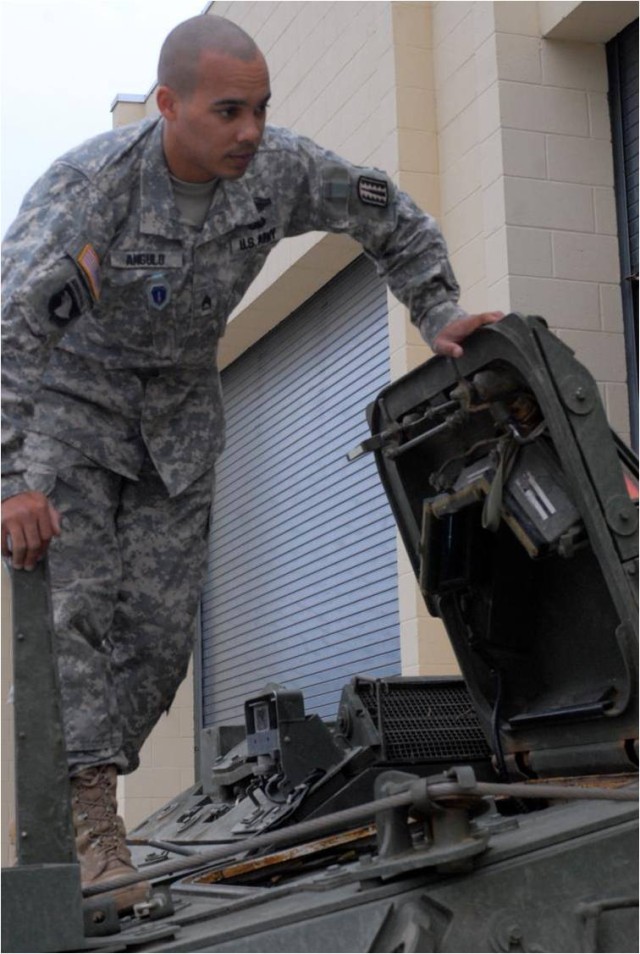FORT BENNING, GA - It's known across the military as "Stryker University."
Each year, the 1st Battalion, 29th Infantry Regiment's Stryker Bradley Instructional Company leads 500 to 600 service members through three programs at the Collins Training Center - the Stryker Transition Course, Stryker Leader Course and Stryker Master Trainer Course. Instructors said all are dedicated to building proficiency with the eight-wheeled light armored vehicles that can operate on all types of terrain and under extreme weather conditions.
SFC Doyle Lockard, the Stryker branch chief, said joint service training on the Stryker Infantry Carrier Vehicle is conducted exclusively at Fort Benning and his unit delivers thorough instruction on the machine's components and capabilities - covering everything from simple maintenance to firing the weapons systems.
"We provide world-class training to all the services who ask for it," Lockard said Tuesday. "Our job is to train the guys (from Special Operations Command) to get in the fight. But we have Navy, Air Force, some Marines and National Guard."
A SEAL platoon from the East Coast went through the basic transition course recently. They were followed this week by a small group of Seabees - mostly construction mechanics - assigned to Navy Special Warfare Group 2, a logistics support unit out of Naval Amphibious Base Little Creek, Va.
"We're here to familiarize ourselves with this vehicle in case we get deployed to a certain area," said Petty Officer 1st Class Christopher Fleming, an equipment operator. "We're getting basic general knowledge of the vehicle, so the mechanics can learn how to break it down and put it back together if we have to ... We're getting up to speed so we can support SEALs and whoever else might use it."
In general, the two-week transition course is limited to service members in pay grades E-1 to E-5, while the leader course is given to E-6 through O-6 in three-week sessions, Lockard said. The master trainer course, which lasts six weeks, is a "train-the-trainer" program designed to provide senior enlisted members and officers with the ability to teach their own units about Stryker use.
After learning the vehicle's mechanics, students enter the common drivers trainer, a simulator that replicates all-weather terrain, night driving and attacks - including rocket-propelled grenades, roadside bombs and small-arms fire.
"It's a good tool," Lockard said. "We can test them in this before they get in the real thing. All the switches and gauges are in the same place."
The students later steer the Strykers through obstacle courses, ditches full of water, and over tank tracks, he said.
"Strykers are less damaging to the road and they get there faster and quieter than tracked vehicles," he said. "The challenge is keeping it on the road, keeping it straight and keeping it from rolling over. These vehicles are top heavy."
Lockard said rollovers are rehearsed and students are taught about procedures and contingency plans to follow.
"We beat safety pretty hard here," he said.
He said students are graded on all aspects of the training, but live-fire scenarios are reserved for the leader and master trainer courses.
SSG Arthur Moran, the Stryker master trainer team chief, said his course was stood up in 2008 and only gets taught five times a year. It's capped at a dozen students per session, which enhances the one-on-one training.
If requested through 1st Battalion, 29th Infantry Regiment, however, mobile training teams can be dispatched around the globe to teach the master trainer course, Moran said.
"We try to make them as much an expert as we can," he said, "so they can put together a training plan and execute it for their respective units.
"It's the most challenging instructional course we have ... You have to give them the most accurate, best knowledge. We're here as part of Stryker University. That's why we have the other branches and SOCOM coming to us."
Fleming, the Sailor, said the transition course instruction was valuable and would definitely be employed by the Seabees in future operations.
"There is no wasted time here. It's vital training for us," he said. "The speed and quietness of the vehicle, its ability to sneak up on (targets), has been effective for Soldiers. We'll be glad our SEALs are able to use it, too."
Lockard said demand for Stryker training is growing as the Army plans to add two more Stryker brigade combat teams to its arsenal. Currently, there are six units on active-duty status and another in the National Guard.
Students normally enroll in the company's Stryker branch individually and not with a unit, Lockard said. But he offered a piece of advice to all.
"Come here as a sponge," he said. "Have an open mind and be prepared to learn."


Social Sharing